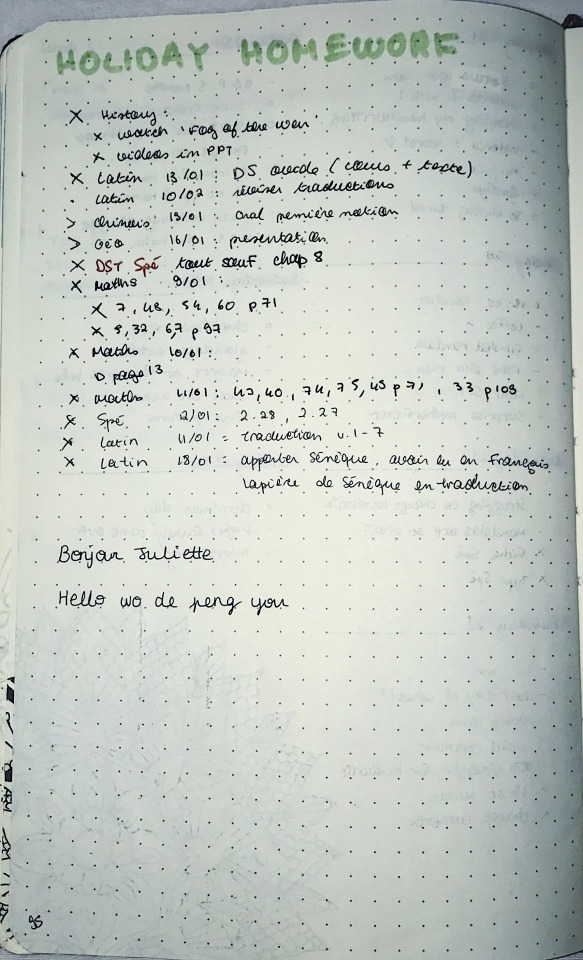Minha Infância.
Minha infância.

He-Man by Stjepan Sejic
More Posts from Lokarprincipal and Others

How to use a bullet journal, student’s edition
I’ve been using a bujo for a year now, and as a high school student, I was struggling to incorporate my bujo into my studies, aka organising my homework and stuff. Before starting a bullet journal I was using a day to day diary where I wrote down all my homework and exams. As I switched to the bujo, I was so happy to have this productivity-boosting tool, yet I couldn’t figure out how I could write down my school-related dates and assignments on my bujo, since it is not designed for long-term planning. So here are the tips I figured out through time (and a lot of studyblr scrolling hehe) on how to use a bujo as a student! Enjoy ^^
1. Have a Semester/trimester/year overview of your school/uni year
This is so far the best tip for long-term planning in your studies. With an overview of your school/uni weeks, it is very easy to jot down exam dates, deadlines, conferences and stuff.

It’s very useful when you are given, at the beginning of your school year, the planning of exams. You can easily jot down the dates and subjects of each exam in this calendar.
You can also add vacations, public holidays and weekends. I also like to highlight the days already gone so that at the end of the school year, I’ll feel the joy of highlighting the last day of school ^^
2. Weekly spreads and assignments columns
This is essential if you want to incorporate your bullet journal with study planning.
It consists of having one column of your page, the weekly assignments overview, dedicated to only writing homework, assignments and upcoming tests. The other part of your weekly spread consists of your usual daily logs. Here are some of my weekly spreads as an example (shoutout to @studypunked for the inspo)



As you can see in the pics, the left column is used solely for writing down my homework and tests.
I also like to add some decorations and pictures to give a bit of life to those weekly spreads.
I also added a month overview and a sleep log each week, but this is personal: you can become creative about how you want your weekly spreads to be.
I usually pre-do these weekly spreads for school weeks after a vacation so that if the teachers give an assignment due in a week or two, I already have the homework column of the due week prepared in advance. When I don’t have school (aka during vacations), I don’t make a weekly spread. I just do my dailies linearly.
3. Useful collections for school
I also like to have some pages of my bullet journal dedicated to other elements related to school:
Homework to do during the holidays:

My grade averages:

A spread dedicated to the list of things I had to do for UK uni application and school during last summer:

And so on… you can get creative and it also depends on your needs for school.
So here it is! This setup worked really well for my senior year and I will definitely continue to use it for university.
I hope this post was useful :)
Sewing Machines & Planned Obsolescence


I've got these two sewing machines, made about 100 years apart. An old treadle machine from around 1920-1930, that I pulled out of the trash on a rainy day, and a new Brother sewing machine from around 2020.
I've always known planned obsolescence was a thing, but I never knew just how insidious it was till I started looking at these two side by side.
I wasn't feeling hopeful at first that I'd actually be able to fix the old one, I found it in the trash at 2 am in a thunderstorm. It was rusty, dusty, soggy, squeaky, missing parts, and 100 years old.
How do you even find specialized parts 100 years later? Well, easily, it turns out. The manufacturers at the time didn't just make parts backwards compatible to be consistent across the years, but also interchangeable across brands! Imagine that today, being able to grab a part from an old iPhone to fix your Android.
Anyway, 6 months into having them both, I can confidently say that my busted up trash machine is far better than my new one, or any consumer-grade sewing machine on the market.
Old Machine Guts


The old machine? Can sew through a pile of leather thicker than my fingers like it's nothing. (it's actually terrifying and I treat it like a power tool - I'll never sew drunk on that thing because I'm genuinely afraid it'd sew through a finger!) At high speeds, it's well balanced and doesn't shake. The parts are all metal, attached by standard flathead screws, designed to be simple and strong, and easily reachable behind large access doors. The tools I need to work on it? A screwdriver and oil. Lost my screwdriver? That's OK, a knife works too.
New Machine Guts


The new machine's skipping stitches now that the plastic parts are starting to wear out. It's always throwing software errors, and it damn near shakes itself apart at top speed. Look at it's innards - I could barely fit a boriscope camera that's about as thick as spaghetti in there let alone my fingers. Very little is attached with standard screws.
And it's infuriating. I'm an engineer - there's no damn reason to make high-wear parts out of plastic. Or put them in places they can't be reached to replace. There's no reason to make your mechanism so unbalanced it's reaching the point of failure before reaching it's own design speed. (Oh yeah there is, it's corporate greed)
100 years, and your standard home sewing machine has gone from a beast of a machine that can be pulled out of the literal waterlogged trash and repaired - to a machine that eats itself if you sew anything but delicate fast-fashion fabrics that are also designed to fall apart in a few years.
Looking for something modern built to the standard that was set 100 years ago? I'd be looking at industrial machines that are going for thousands of dollars... Used on craigslist. I don't even want to know what they'd cost new.
We have the technology and knowledge to manufacture "old" sewing machines still. Hell, even better, sewing machines with the mechanical design quality of the old ones, but with more modern features. It would be so easy - at a technical level to start building things well again. Hell, it's easier to fabricate something sturdy than engineer something to fail at just the right time. (I have half a mind to see if any of my meche friends with machine shops want to help me fabricate an actually good modern machine lol)
We need to push for right-to-repair laws, and legislation against planned obsolescence. Because it's honestly shocking how corporate greed has downright sabotaged good design. They're selling us utter shit, and expecting us to come back for more every financial quarter? I'm over it.
Todos bons conselhos.
10 Ways to Simplify Life
1. Don’t try to read other peoples’ minds and don’t expect others to be able to read yours. Communicate if it is important to you.
2. Don’t expect to be friends with everyone. We all are different – and we all like different things. Instead, invest your time in a few good friends. That’s all you really need to feel happy and fulfilled.
3. Create a budget and live within your means. Accruing debt will only cause you to feel stressed.
4. Get rid of the monster of jealousy, and only compare yourself with yourself.
5. Organize your clutter and get rid of some stuff. It will leave you feeling calmer, and will save a lot of time.
6. Stay on the sidelines and don’t get drawn into pointless dramas in other peoples’ lives (unless it’s a crisis – and you know you ought to help).
7. Finish what you’ve started, and then do something else.
8. Treat every person you meet with respect, and err on the side of being patient and kind.
9. Accept there are things that you can’t change or control, and focus on those things that you can change or control.
10. Don’t be too proud to apologise. Admit that you were wrong, say you’re sorry, and move on.
Because she’s mesmirizing…


Fluffy kitty
Será que temos isso aqui no Brasil também ?
🙏


Uma imagem vale mais que mil palavras.

-
 scuffedinsignia liked this · 8 months ago
scuffedinsignia liked this · 8 months ago -
 mega-mike-2-0 liked this · 8 months ago
mega-mike-2-0 liked this · 8 months ago -
 rubyinajar liked this · 2 years ago
rubyinajar liked this · 2 years ago -
 luchami reblogged this · 5 years ago
luchami reblogged this · 5 years ago -
 captaingalaxyguy reblogged this · 5 years ago
captaingalaxyguy reblogged this · 5 years ago -
 rcomfort94 reblogged this · 5 years ago
rcomfort94 reblogged this · 5 years ago -
 foxopoly liked this · 5 years ago
foxopoly liked this · 5 years ago -
 quiamg liked this · 5 years ago
quiamg liked this · 5 years ago -
 southernpeach13 liked this · 5 years ago
southernpeach13 liked this · 5 years ago -
 magicofthepiper liked this · 6 years ago
magicofthepiper liked this · 6 years ago -
 drasticlyplasticly reblogged this · 6 years ago
drasticlyplasticly reblogged this · 6 years ago -
 el-mejorge reblogged this · 6 years ago
el-mejorge reblogged this · 6 years ago -
 from-disney-to-rwby liked this · 6 years ago
from-disney-to-rwby liked this · 6 years ago -
 fa2ff liked this · 6 years ago
fa2ff liked this · 6 years ago -
 brucewombs liked this · 6 years ago
brucewombs liked this · 6 years ago -
 this-is-emzy liked this · 6 years ago
this-is-emzy liked this · 6 years ago -
 lokarprincipal reblogged this · 6 years ago
lokarprincipal reblogged this · 6 years ago -
 lokarprincipal liked this · 6 years ago
lokarprincipal liked this · 6 years ago -
 joannas-interesting-quest liked this · 6 years ago
joannas-interesting-quest liked this · 6 years ago -
 nobeerreviews liked this · 6 years ago
nobeerreviews liked this · 6 years ago -
 3rdagetaveren liked this · 6 years ago
3rdagetaveren liked this · 6 years ago -
 skulldiamond94 liked this · 6 years ago
skulldiamond94 liked this · 6 years ago -
 simian-bearsfoot liked this · 6 years ago
simian-bearsfoot liked this · 6 years ago -
 obsidianwolfxredux reblogged this · 6 years ago
obsidianwolfxredux reblogged this · 6 years ago -
 anubis-things liked this · 6 years ago
anubis-things liked this · 6 years ago -
 amnducyaz liked this · 6 years ago
amnducyaz liked this · 6 years ago -
 dta1 reblogged this · 6 years ago
dta1 reblogged this · 6 years ago -
 dta1 liked this · 6 years ago
dta1 liked this · 6 years ago -
 corefragments liked this · 6 years ago
corefragments liked this · 6 years ago -
 gfbfwe reblogged this · 6 years ago
gfbfwe reblogged this · 6 years ago -
 oroshimaru1974 liked this · 6 years ago
oroshimaru1974 liked this · 6 years ago -
 manof2moro reblogged this · 6 years ago
manof2moro reblogged this · 6 years ago -
 peloncito21 liked this · 6 years ago
peloncito21 liked this · 6 years ago -
 jeigh-91 liked this · 6 years ago
jeigh-91 liked this · 6 years ago -
 bo1230321 liked this · 6 years ago
bo1230321 liked this · 6 years ago -
 templarhalo liked this · 6 years ago
templarhalo liked this · 6 years ago -
 3zlow liked this · 6 years ago
3zlow liked this · 6 years ago -
 diamantisl liked this · 6 years ago
diamantisl liked this · 6 years ago
